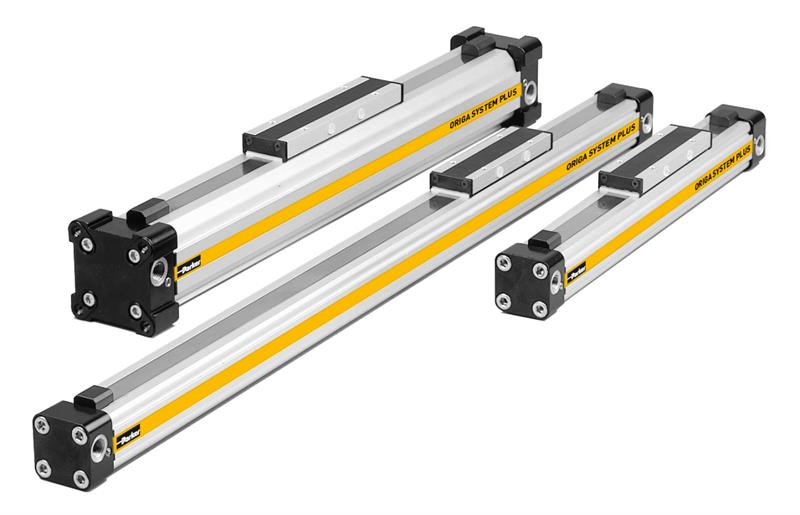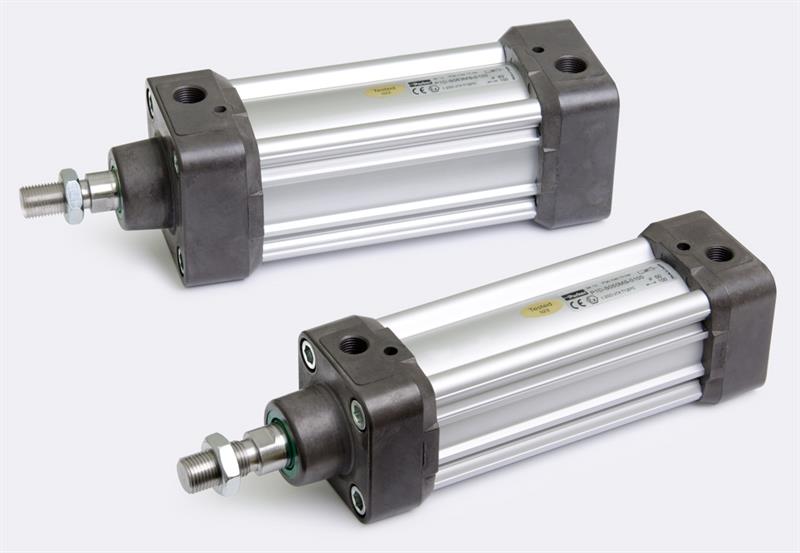For example, pneumatic actuators don’t deliver high force output, but are practical when a cost-effective, easy start-up is required. Conversely, hydraulic linear actuators are suited to high force applications but generate a lot of noise. And, while electromechanical actuators are quieter, they are much more difficult to install and maintain.
So, what are the considerations and trade-offs when selecting linear actuators for a linear motion application?
Pneumatics
There have been several recent improvements in pneumatic design, including positional feedback capabilities from proximity and linear position sensors. Better sealing has also allowed pneumatic linear actuators to be used more often in challenging environments or applications requiring wash down.
However, pressure losses and the compressibility of air can make pneumatics less efficient than other linear technologies. While the speed ranges from a couple of centimetres per second to 150cm/s, force output is dependent on the maximum pressure rating and related bore size. Typically, however, pneumatic actuators have a maximum pressure rating of 10bar with bore sizes ranging from 12 to 320mm for approximately 80N to 80kN.

Hydraulics
Hydraulic systems therefore have a much higher possible force output, with typical pressure ratings up to 210bar with bore sizes ranging from approximately 12 to 355mm translating to about 220 to 171,000N of force. Hydraulic actuation also generates a significant amount of noise and, without proper maintenance, can leak.
Electromechanical
When driven by a rotary motor, electromechanical linear motion systems employ one of four rotary-to-linear conversion systems: ballscrew, roller screw, Acme (lead) screw, or belt drive. In addition, a linear motor can be used to provide motion.
A linear motor is similar to a rotary motor, but the motor coils make up the forcer. Depending on the design, one or two rows of magnets comprise the magnet track. In a rotary motor, the rotor spins while the stator is fixed, but in a linear motor, either the forcer or the magnet track can be the moving component, which is then integrated with an appropriate linear bearing. By sending electrical current to the forcer, the resulting magnetic field interacts with the magnet track and drives the linear motor carriage back and forth.
Linear motors have high dynamic performance, with acceleration of greater than 20G at velocities of 10m/s or higher. Due to the direct drive nature of linear motors, there are no mechanical components to add backlash, torsional wind-up, or other positioning errors. Sub-micron resolution and repeatability are achievable and as the motor is directly coupled to the load, there are fewer components to fail, which adds long-term reliability.
Ballscrews
Most linear motion applications, including positioning tables, convert motor torque to linear thrust using ballscrews. They are characterised by high thrust (up to 9000N) and they generate high speeds at shorter stroke lengths – up to 1.8m/s. Ballscrews can be precise from 10 to 50mm and some manufacturers rate them for 100 to 2,500km of total lifetime travel.
Sometimes, their bearings ride on the flights or leads of the screw for 95% efficiency or better.
Rolled ballscrews are lower cost, whereas ground ballscrews deliver higher critical speeds. In some models, re-engineered recirculating ball tubes are designed especially for screws, including lubrication seals on the ball nut end, which reduces noise as much as 7dB.
Roller screws
This is the most recent evolution of the ballscrew. The latest roller screws incorporate multiple roller bearings in the nut, which operate like planetary gears around the screw itself. Roller screws provide high efficiency, duty cycles exceeding 50%, and acceleration from 1 to 2G. Typical stroke lengths range from 5mm to 2m; speeds can reach 1.8m/s. In short, roller screws have the speeds of ballscrews, but possess much higher thrust capacity and force density.
Roller screws are used in many small machine presses and injection moulding machines. The downside of roller screw technology is its low availability because the technology is relatively new, so lead-time and prices are generally significantly higher than ballscrews.

Acme screws
Acme screws, also known as lead screws, are one of the simplest and lowest cost mechanisms for converting rotary power to linear. However, because there are no rolling ball bearings, they transfer only 30 to 50% of the motor’s energy to driving the load. The remaining energy is lost to friction and generated heat. Heat limits the duty cycle of Acme screws to less than 50%. Despite this, Acme screws are useful for applications with low speeds and duty cycles below 50%, and those that must hold position while the motor power is off — such as while holding a vertical load.
Belt drives
Belt drives offer many of the benefits of ballscrews, but have fewer moving parts and no critical speed limitations, making it suitable for higher travel speeds with minimal component wear. Belt drive designs, however, have lower repeatability and accuracy.
Some product designs allow tensioning at the carriage. Others allow tensioning at the idler end cap of the actuator, because it eliminates the need to remove any load while tensioning the belt.
Making a measured choice
Designers can take four main categories of requirements into consideration when choosing a linear actuator: Precision, Expected life, Throughput and Special considerations (PETS). For example, if precision is considered to be the most important factor, a linear drive or a precision ball screw will be more suitable for the job, but is likely to be more expensive. Where precision is not a high priority, a belt drive may prove to do the job more economically.
Placing a priority on one type of application parameter could mean that performance in another area might be sacrificed, but nevertheless all the decision making categories should be carefully weighed up before making the final choice of actuator equipment.
About the author:
Rebecca Hammes is business unit manager for actuators at Parker Hannifin





